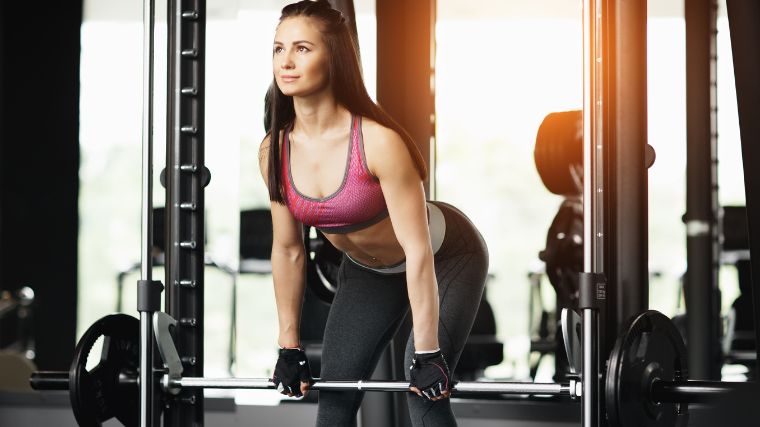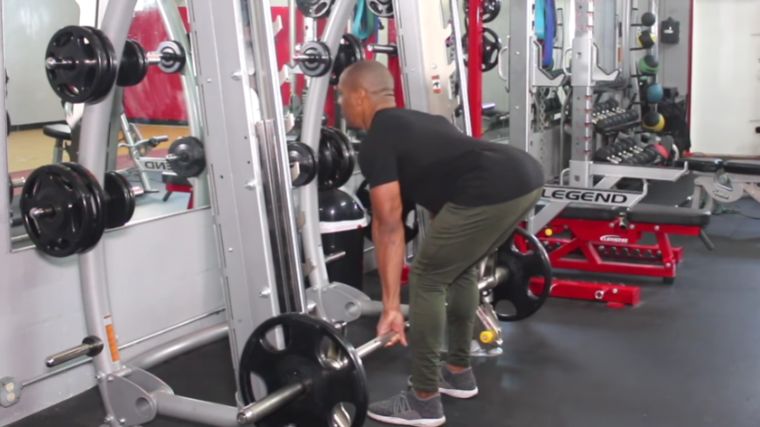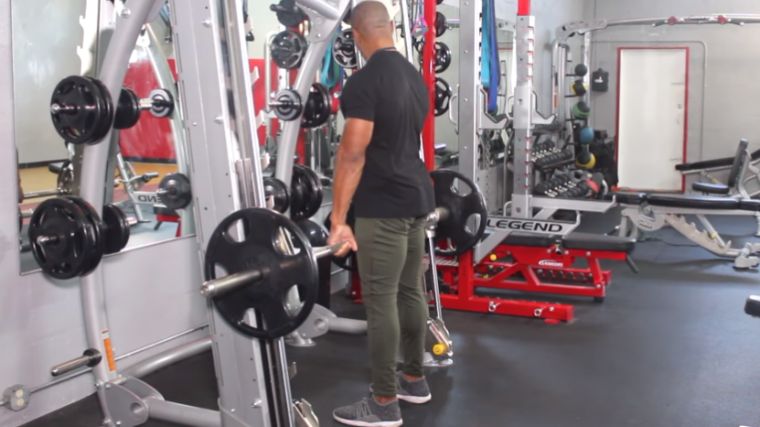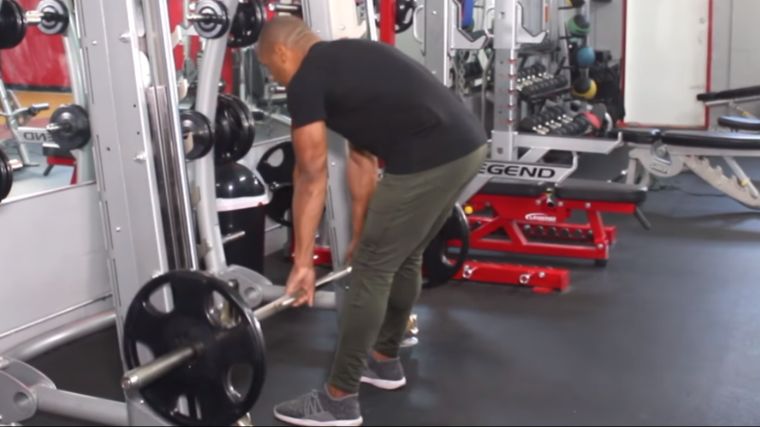The Smith machine deadlift is one of the best-kept secrets in weight training. Although it may look and feel different than your normal deadlift, building strength, skill, and muscle are right at your fingertips. The real selling point, though, is accessibility: The Smith machine deadlift is accessible in nearly every commercial gym.
The Smith machine itself is a unique but often misunderstood piece of equipment. Instead of a freely-moving barbell, the Smith machine is locked into a predefined range of motion. This makes learning and executing movements like the Smith machine deadlift a breeze.

If you’re in a jam and can’t get ahold of a barbell, Smith machine deadlifts easily come to the rescue. With that in mind, here’s how to do the Smith machine deadlift.
- How to Do the Smith Machine Deadlift
- Smith Machine Deadlift Variations
- Smith Machine Deadlift Alternatives
- Smith Machine Deadlift Tips
- Benefits of the Smith Machine Deadlift
- Muscle Worked by the Smith Machine Deadlift
- Who Should Do the Smith Machine Deadlift
- Common Smith Machine Deadlift Mistakes
- Frequently Asked Questions
How to Do the Smith Machine Deadlift
The Smith machine deadlift is a great way to train the posterior chain, but there are a few key steps to getting it right. Here is a guide to set-up and execute your Smith machine deadlift.
Step 1 — Set Up

Approach the bar with your feet about shoulder-to-hip width apart and directly over your mid foot. Your feet should be facing straight ahead or slightly flared out to comfort. Make sure to maintain even body weight distribution from heel to toe.
Coach’s Tip: Your stance should feel strong and stable — try using a standing vertical jump to gauge a good stance.
Step 2 — Hinge

Breathe out your air through pursed lips to stack your ribcage directly on top of your hips. Brace your abdominals and begin sliding your hips backwards. Once you feel a stretch across your glutes and hamstrings, you are in your hinge. Grab the bar with a close overhand or mixed grip, just outside your shins.
Coach’s Tip: Once your hips stop moving back, your hinge is complete; any more and you’ll start to bend at the back.
Step 3 — Pick It Up

Reinforce your brace by flexing your abdominals, lats, and tensing your legs. Initiate the Smith machine deadlift by “pushing the earth away,” driving through your quads and pulling with your hamstrings. Flex the glutes hard to secure your lockout.
Coach’s Tip: Control the lowering portion to reset each repetition by moving back into the hinge position.
Smith Machine Deadlift Variations
The Smith machine deadlift is a fantastic exercise in its own right, but it also has some useful variations. The Smith machine Romanian deadlift, B-stance deadlift, and single-leg Romanian deadlift also offer distinct benefits.
Smith Machine Romanian Deadlift
The Romanian deadlift is a partial range of motion variation that emphasizes the top half of your normal deadlift. Perform the Smith machine Romanian deadlift by hinging at your hips. Finish the range of motion once the bar passes your knees or when you feel a deep stretch in the glutes and hamstrings.
[Read More: The Best Online Workout Programs For Coaching, Cardio, Value, And More]
Flex your hips and hamstrings to draw the bar back to the standing position. The Smith machine Romanian deadlift is a fantastic tool to perfect your hinge while making big glute and hamstring gains.
Smith Machine B-Stance Deadlift
The Smith machine B-stance deadlift allows you to emphasize each side of your body a bit more without going fully unilateral. The B-stance is a staggered foot position that ensures your forward leg is doing the brunt of the work while your trailing leg acts like a kickstand.
Make some big single-leg strength and muscular balance gains without being restricted by your ability to balance on one foot.
Smith Machine Single-Leg Romanian Deadlift
The Smith machine single-leg Romanian deadlift is the ultimate unilateral tool. From the standing position, perform a hinge at the hips with only your working leg on the ground. Keep your trailing leg fully locked out floating behind you.
The Smith machine single-leg Romanian deadlift is a perfect balance of unilateral training with assistive stability. Make huge muscle gain evenly between each leg and take advantage of a stable bar path to help you focus on effort alone.
Smith Machine Deadlift Alternatives
If you’re looking to make some similar gains without performing the Smith machine deadlift, try the Smith machine hip thrust, squat, or split squat.
Smith Machine Hip Thrust
The Smith machine hip thrust allows you to train the glutes hard and mimic your hinge position while lying down. Placing the bar on your hips encourages your hip hinge — all you need to do is secure a strong brace.
[Read More: The Best Foods for Energy Before, During, and After Your Workouts]
Your foot pressure, core engagement, and hip extension mirrors the Smith machine deadlift with less demand on mobility. If you’re looking for an easy-mode way to build your glutes, the Smith machine hip thrust is a great alternative.
Smith Machine Squat
The Smith machine squat trains your full body but is a different movement pattern than the Smith machine deadlift. While the Smith machine deadlift emphasizes your glutes and hamstrings, the Smith machine squat hits your quads, glutes, and adductors.
Both take some full body coordination and bracing, but you’ll map out a slightly different muscle emphasis based upon your goals.
Smith Machine Split Squat
The Smith machine split squat is a great way to train each side of your body individually. Similar to the Smith machine single-leg Romanian deadlift, the Smith machine split squat challenges each of your legs in isolation.
The Smith machine split squat also benefits from some external stability. Where your Smith machine romanian deadlift emphasizes your glutes and hamstrings, the Smith machine split squat smokes your quads and glutes.
Smith Machine Deadlift Tips
The Smith machine deadlift has a long progression potential. To see the best results, start light, progress slowly, and remember it is not the same as a standard deadlift.
Start Light
With any multi-joint exercise, you want to start light. The Smith machine deadlift calls a ton of muscle mass into action and requires a great deal of coordination. Starting light helps you train with clean repetitions that reinforce proper execution and build your body proportionally. Focus on perfecting your technique before adding weight.
Progress Slowly
Your progress on the Smith machine deadlift is reliant upon many moving parts. Your glutes and hamstrings are big factors here, but less obvious components like grip strength are important to consider as well.
[Read More: Build a Titanic Torso with These Bodybuilding Chest & Back Workouts]
Making the smallest jumps possible allows each of your individual muscles to keep pace with the progress of your legs. Add no more than five or 10 pounds per week, and only if you can maintain good form along the way.
It’s Not a Standard Deadlift
The Smith machine deadlift is a unique movement pattern compared to your standard deadlift. You certainly perform a hinge and use your full body, but the Smith machine deadlift is locked in a predefined path. You won’t be able to compensate or shift your positioning around like you would using a free bar.

In order to lock in your Smith machine deadlift technique, you likely have to slightly modify how you would normally deadlift on a free bar. If you set up too far off the bar, for example, there will be an unfixable gap between your legs and the bar, increasing pressure on your back and compromising your leverage.
Benefits of the Smith Machine Deadlift
The Smith machine deadlift is a great tool to build strength, muscle, and to learn the hinge movement. It also gains points for convenience, which is invaluable if you hit the gym at its busiest hours.
Build Strength
Although the Smith machine deadlift is in a predefined path, that doesn’t mean you won’t build some serious strength. A Smith machine deadlift works similar to how a leg press or hack squat builds your lower body strength. The locked-in bar path allows you to load your Smith machine deadlift on the heavier side, driving some great full body strength development.
Build Muscle
The Smith machine deadlift and its variations are fantastic for growing muscle. One of the most common plateaus you may experience with barbell exercise is your ability to stabilize the weight you’re working with.
[Read More: The 12 Best Supplements for Muscle Growth]
Your legs might still have more gas, but your ability to control the path of the bar starts to fail. With the Smith machine deadlift you’re able to focus much harder on getting your legs close to failure without your pesky stabilizers limiting you.
Learn to Hinge
One of the harder skills to master is your hip hinge. The Smith machine puts your hinge pattern on training wheels, allowing you to focus on sending your hips back. With the bar being locked in a predefined path, you won’t need to worry about controlling where it moves as you learn to control your hinge.
Muscles Worked by the Smith Machine Deadlift
The Smith machine deadlift works an enormous amount of muscle mass. The glutes and hamstrings are the major players, but your quads, core, and back are also responsible for a ton of work.
Glutes
Your glutes are the largest muscles of your lower body; they’re made up of your gluteus maximus, medius, and minimus. Your gluteus maximus is the largest of your three glutes and is responsible for extending your hip. During the Smith machine deadlift, your glutes are one of the prime movers, meaning that they produce some of the highest forces to actually lift the weight.
Hamstrings
Your hamstrings also help extend your hips during the Smith machine deadlift. Your hamstrings are the entire backside of your upper leg, spanning from just below the knee to just above the hip. Combined with your glutes, the hamstrings are the workhorse of your Smith machine deadlift.
Quadriceps
Your quadriceps are responsible for extending your knees. They are a group of four huge muscles that make up the front of your thigh. Based upon your individual body proportions, the amount of quadriceps engagement you get on your Smith machine deadlift might vary. If your starting position has more knee bend, you’ll need to use more quads to start your lift.
Core
Your core plays a large role in successfully performing the Smith machine deadlift. Your legs do the lifting, but your core is making sure you don’t fold under the load. Your core is composed of your abdominals, back musculature, and even some of the deep muscles in your hips. When your core is engaged your spine and pelvis are stabilized to help transfer force from your legs into the barbell.
Back
Your back is heavily involved in a Smith machine deadlift. Your traps and lats keep your back from rounding as you lift. In conjunction with your core musculature, your back stiffens your torso to effectively transfer force from your legs into the bar.
Forearms
While often overlooked, your forearms are very important in the Smith machine deadlift. Your forearm muscles are heavily involved in grip strength. As you load up the Smith machine deadlift, your grip is challenged to keep you attached to the bar. Squeeze tight.
Who Should Do the Smith Machine Deadlift
The Smith machine deadlift is useful for beginners, bodybuilders, and lifters in a rush. If you fall into any of those camps, you might want to give the move a shot.
Beginners
You have a ton of new skills to learn when you’re just getting started in the gym. From getting your bearings on all the new machines, establishing a routine, and learning how to coordinate free weights, it’s a lot.
The Smith machine deadlift is an excellent introduction to your hip hinge pattern as a beginner. The stabilized bar path is a huge asset when you’re trying to learn to groove your hips, helping build a ton of early muscle, too.
Bodybuilders
One of your biggest assets in bodybuilding is stability. Isolating and training your preferred muscle as hard as possible is the goal, but there are a ton of stabilizers and coordination in your way.
[Read More: The Definitive Guide to Bodybuilding Meal Prep]
The Smith machine deadlift focuses more on strictly contracting the glutes and hamstrings because of the preset range of motion. You’ll need to devote less energy to stabilizing your lift and more on torching your legs.
Lifters in a Rush
A free bar version of the deadlift is a great tool in its own right, but you might need more time to warm-up before it’s effective. The stability and coordination requirements of your standard deadlift makes a Smith machine version quite appealing in a rush.

If you don’t have a ton of time but still want to hit your hips and hamstring really hard, the Smith machine deadlift will get you working lightning quick.
Common Smith Machine Deadlift Mistakes
The most common Smith machine deadlift mistakes are taking an improper stance, grip, or simply squatting the weight.
Improper Stance
Your stance in the Smith machine deadlift should be about hip to shoulder width and the bar placed smack dab over your midfoot. A common mistake is taking a much too wide stance or keeping the bar too far away from your body.

If you’re struggling to find your starting position, a great landmark is to place the bar about an inch away from your shin. Next, try taking a stance that mimics your standing vertical jump and make small adjustments from there.
Improper Grip
Grabbing the bar improperly has a big impact on your Smith machine deadlift. Too wide and you’ll need to bend over too much. Too narrow and you might struggle to keep your back tight. A good rule of thumb here is to allow your arms to relax and lay comfortably at your sides. This is a great place to start for your Smith machine deadlift grip width.
Squatting the Weight
The Smith machine deadlift is a hinge. As such, one of the most common errors is squatting the weight. Your squat uses much more knee bend than you would find in your hinge and takes a lot of the emphasis off of your posterior chain. Set up using as deep of a pure hinge as possible before bending your knees only as much as necessary to reach the bar.
Smithing Up Some Gains
The Smith machine is a clever training tool that is often overlooked for its barbell counterpart. While the barbell is fantastic in its own right, you cannot deny the benefits of a good Smith machine workout.
The Smith machine deadlift is a wonderful way to build your glutes and hamstrings without being limited by stability. It’s also a powerful tool to learn how to hinge. If you’re a beginner, bodybuilder, or just plain short on time, the Smith machine deadlift is clutch. Be sure to start light, progress slowly, and appreciate its unique form and you’ll be Smithing your way to gains in no time.
FAQs
Still scratching your head about the Smith machine deadlift? No worries. Here’s what you need to know.
Is the Smith machine deadlift safe?
Although all exercises have some inherent risk, the Smith machine deadlift is no more risky than anything else when executed properly. The Smith machine keeps your movement pattern tucked into a specific path making it arguably more predictable and safer to navigate. It also has safety stoppers in case of emergency.
Is the Smith machine deadlift functional?
A common argument against Smith machine work is that the preset bar path makes them not as “functional” as a free weight. While the Smith machine deadlift is certainly in a preset bar path, not every exercise needs to be completely free moving to be valuable. Function is as unique to you as your individual goals are — keep a diverse range of exercises in your program for the most balanced benefits possible.
How should I progress my Smith machine deadlift?
You should use progressive overload to see gains on your Smith machine deadlift. Progressive overload is the manipulation of sets, repetitions, rest periods, load, or any other training variable to progress the challenge workout-over-workout. As you get stronger or build muscle, the challenge must increase to keep the stimulus effective. Slowly increase repetitions, sets, and finally load to see great progress.
Feature Image: sklyareek / Shutterstock